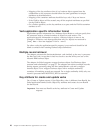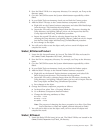IsKey
=
true
IsFireignKey
=
false
IsRequired
-
false
AppspecificInfo
=
SF=QuoteId;DF=QuoteId
Assigning
the
value
of
an
attribute
to
another
attribute
Attribute
application-specific
information
can
be
coded
so
that
the
connector
obtains
a
value
for
an
attribute
and
assigns
it
to
another
attribute
before
the
second
attribute
is
processed.
This
functionality
is
used
in
a
Retrieve
operation
and
is
primarily
used
on
container
attributes
to
specify
which
record
for
the
child
should
be
retrieved.
To
use
this
functionality,
edit
the
attribute
application-specific
information
in
the
business
object
definition
to
include
the
following
text:
From=attribute;To=attribute;
The
attribute
path
value
can
be
an
attribute
name
in
the
current
business
object.
Note
the
following
rules:
v
The
From
attribute
is
an
attribute
from
the
parent,
and
the
To
attribute
is
the
child
attribute.
v
The
From
attribute
must
be
populated
before
the
to
attribute
in
the
instruction
can
be
processed.
v
The
To
attribute
is
set
only
if
it
has
a
null
value.
v
If
the
path
is
invalid
for
the
from
parameter,
the
to
parameter
is
set
to
null.
If
the
path
is
invalid
for
the
to
parameter,
no
error
is
flagged.
v
The
From/To
directive
can
be
specified
only
in
the
application-specific
information
of
an
attribute
on
a
child
business
object.
In
other
words,
it
cannot
be
specified
on
a
top-level
business
object.
For
example,
if
a
Siebel_BCQuote
business
object
includes
a
child
business
object
Siebel_BCAccount,
attributes
in
the
Siebel_BCQuote
object
can
specify
which
address
from
the
PickList
is
retrieved.
In
this
example,
AccountId
is
the
key
attribute,
and
Siebel_BCAccount
is
the
picked
object.
The
connector
gets
the
value
of
the
AccountId
attribute,
and
uses
that
value
to
retrieve
the
specific
account.
The
child
attributes
are
processed
after
the
attributes
in
the
parent
business
object.
The
following
example
shows
the
processing
flow
of
attributes
from
parent
to
child
business
objects.
[Siebel_BCQuote]
Name
=
Account
Type
=
String
AppSpecificInfo
=
FN=Id
Name
=
Account
Type
=
Siebel_BCAccount
Relationship
=
Containment
Cardinality
=
1
IsForeignKey
=
false
AppSpecificInfo
=
LFN=Address;PL=true;From=AccountId;To=AccountId
[Siebel_BCAccount]
Name
=
AccountId
IsKey
=
true
AppSpecificInfo
=
...
Specifying
pickList
relationships
Some
PickList
relationships
require
the
creation
of
the
picked
child
object
in
the
same
transaction.
In
WebSphere
business
integration
system
business
objects,
a
PickList
relationship
between
parent
and
child
business
objects
is
represented
by
46
Adapter
for
Siebel
eBusiness
Applications
User
Guide


















